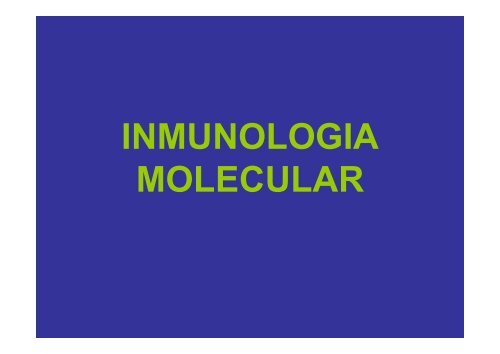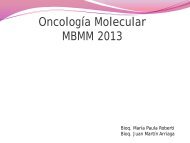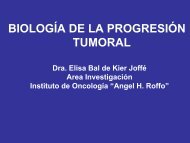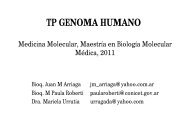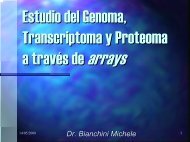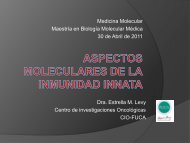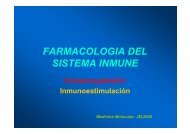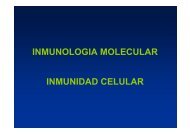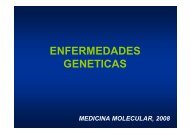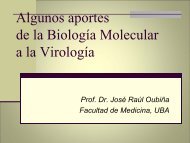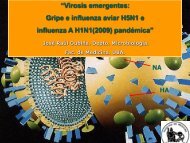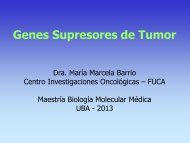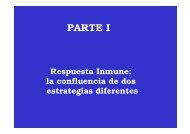INMUNOLOGIA MOLECULAR
INMUNOLOGIA MOLECULAR
INMUNOLOGIA MOLECULAR
Create successful ePaper yourself
Turn your PDF publications into a flip-book with our unique Google optimized e-Paper software.
<strong>INMUNOLOGIA</strong><br />
<strong>MOLECULAR</strong>
HUMORAL<br />
CELULAR<br />
INMUNIDAD IgM Macrófagos<br />
NATURAL<br />
Células NK<br />
(sin memoria)<br />
Neutrófilos<br />
INMUNIDAD IgG Linfocitos CD4+<br />
ADAPTATIVA<br />
(helper)<br />
(con memoria)<br />
Linfocitos CD8+ (CTL)<br />
JM/03<br />
Medicina Molecular
Pathways of differentiation of a pluripotent<br />
hematopoietic stem cell of the bone marrow<br />
differentiate in the thymus<br />
Stem<br />
cells<br />
136380<br />
differentiate in the bone marrow
ANTIGENOS<br />
Moléculas reconocidas por<br />
receptores en células B (B cell<br />
receptor) o T (T cell receptor).<br />
Hapteno : antígeno que para ser<br />
reconocido debe ser unido a un<br />
carrier (hidratos de carbono)
How many environmental<br />
antigens are we exposed to<br />
during our lifetime?<br />
The immune system responds to hundreds of thousands of<br />
foreign antigens introduced from the environment
Examples of antigen, immunogen<br />
and epitopes<br />
Epitope A<br />
Epitope B<br />
Antigen<br />
Antibody A<br />
Antibody B<br />
Epitope B<br />
Immunogen<br />
Antibody B
ANTICUERPOS
RECEPTORES ANTIGENICOS<br />
• B cell receptor (linfocitos B) = reconoce<br />
Ag nativo<br />
• T cell receptor (linfocitos T) = reconoce<br />
Ag procesado<br />
JM/00<br />
Medicina Molecular
ANTIGENO CON MULTIPLES<br />
EPITOPES<br />
SUERO CON MULTIPLES<br />
ANTICUERPOS
The Immune Response:<br />
APC<br />
Ag<br />
Ag Processing<br />
B<br />
Ab<br />
CD8<br />
1. 2.<br />
Help<br />
Help<br />
CD4
LINFOCITO CD4 ACTIVADO
Role of T-Helper cells<br />
in antibody formation.
LINFOCITO B EN REPOSO
LINFOBLASTOS B
Lymph node
Germinal center in lymph node
PLASMOCITO
PLASMOCITO<br />
APOPTOTICO
136384<br />
Primary and secondary antibody responses.
¿Cómo se produce la gran<br />
diversidad de anticuerpos?
Susumu Tonegawa<br />
Premio Nobel 1987
Producción de cadena κ
GENES CODIFICANTES PARA<br />
INMUNOGLOBULINAS<br />
• Cluster IGH: cadena H; crom.14;V,D,J,C.<br />
• Cluster IGK: cadena K; crom.2; V,J,C.<br />
• Cluster IGL(λ): cadena λ; crom. 22; V,J,C.
ANTICUERPOS<br />
MONOCLONALES
Niels K. Jerne<br />
Georges J.F. Köhler<br />
César Milstein<br />
1/3 of the prize<br />
1/3 of the prize<br />
1/3 of the prize<br />
Denmark<br />
Federal Republic of Germany<br />
Argentina and United Kingdom<br />
Find a Laureate:<br />
Basel Institute for Immunology<br />
Basel, Switzerland<br />
Basel Institute for Immunology<br />
Basel, Switzerland<br />
MRC Laboratory of Molecular Biology<br />
Cambridge, United Kingdom<br />
b. 1911<br />
d. 1994<br />
b. 1946<br />
d. 1995<br />
b. 1927<br />
(in Bahia Blanca, Argentina)<br />
d. 2002
• antibodies produced by<br />
differentiated B-cells<br />
• recombination results in B-cell<br />
lineages producing distinct<br />
antibodies<br />
• serum contains antibodies<br />
representing many lineages<br />
• difficult to isolate B-cells of<br />
defined specificity<br />
• cannot grow B-cells in culture<br />
Kohler and Milstein (1975)<br />
• fused B-cells with myeloma<br />
cells stable hybridoma<br />
• hybridoma secretes<br />
monoclonal antibody
• immunized mouse making<br />
desired antibodies<br />
• boost 3-4 days before fusion<br />
• remove spleen and harvest<br />
cells<br />
• mix with myeloma cells in<br />
presence of fusogenic agent<br />
Balb/c Mouse<br />
<br />
MOPC 21 (tumor)<br />
<br />
P3K (cell line)<br />
<br />
P3-X63Ag8 (HGPRT-)<br />
<br />
X63-Ag8.653 (IgG-)
HAT Medium:<br />
• Hypoxanthine<br />
(purine salvage)<br />
• Aminopterin<br />
(DHFR inhibitor)<br />
• Thymidine<br />
(pyrimidine salvage)<br />
Nucleotide Metabolism:<br />
• salvage and de novo<br />
pathways<br />
• HGPRT essential for<br />
purine salvage<br />
• DHFR essential for de<br />
novo synthesis<br />
HGPRT = hypoxanthine-guanine phosphoribosyl transferase<br />
DHFR = dihydrofolate reductase
Selection in HAT Medium<br />
Human mAbs produced by transforming<br />
lymphocytes with EBV
Screening/Cloning<br />
Cloning Methods<br />
• soft agar<br />
• limiting dilution
Production<br />
• produce mAbs in vitro or<br />
with ascites<br />
• harvest culture media<br />
(supernatant)<br />
– in vitro material is less<br />
concentrated and<br />
contains bovine serum<br />
• ascites are tumors grown<br />
in peritoneal cavity<br />
– ascites fluid and sera<br />
contain high [mAb]<br />
– minor contamination<br />
with mouse IgG
HAMA ("human antimouse<br />
antibodies").
Humanized Monoclonal Antibodies<br />
Mouse monoclonal antibodies have<br />
been genetically engineered to replace<br />
all of the antibody molecule with human<br />
counterparts except the hypervariable<br />
regions directly involved with antigen<br />
binding.<br />
Humanized monoclonal antibodies are<br />
currently be tested in human clinical<br />
trials.
RECEPTORES ANTIGENICOS<br />
• T cell receptor (linfocitos T) = reconoce Ag<br />
procesado<br />
• B cell receptor (linfocitos B) = reconoce Ag<br />
nativo
MECANISMO DE ACCION<br />
DE LOS ANTICUERPOS<br />
Via Complemento<br />
ADCC (antibody-dependentcellular-cytotoxicity
• COMPLEMENTO
MAC (complejo ataque<br />
complemento)


